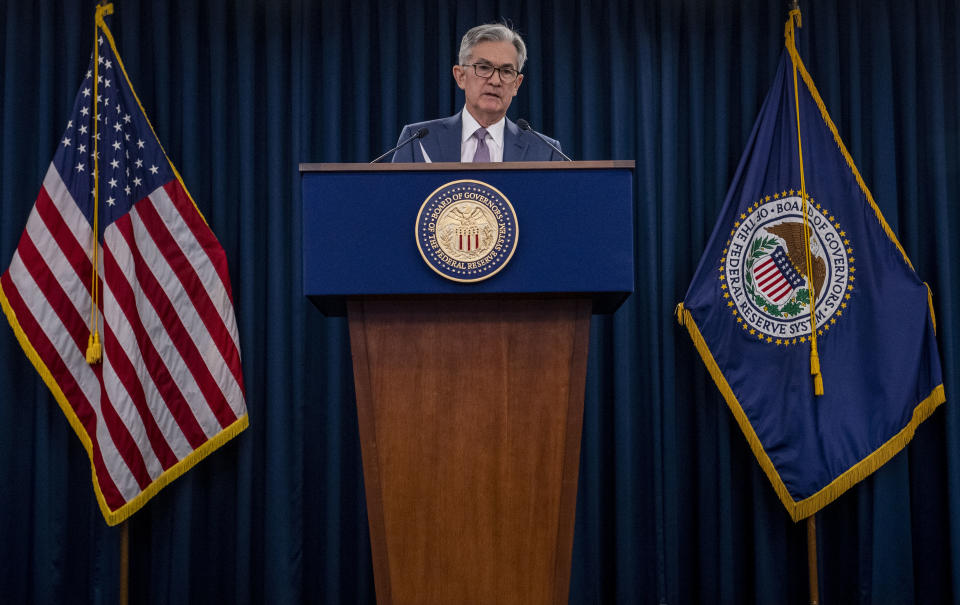Powell: Fed will act 'forcefully, proactively, and aggressively' to support the US economy
Federal Reserve Chairman Jerome Powell said Thursday that the Fed is “doing all we can” to support the U.S. economy through the novel coronavirus.
“We will continue to use these powers forcefully, proactively, and aggressively until we are confident that we are solidly on the road to recovery,” Powell said in a webcast with the Brookings Institution.
Earlier in the morning, the Fed announced $2.3 trillion in funding supported by the U.S Treasury and money appropriated through the Coronavirus Aid, Relief, and. Economic Security (CARES) Act. In addition to offering more details on a Main Street Lending Program, the Fed also said it will open up a facility dedicated to buying short-term municipal debt and would expand its existing facilities in size and scope.
Powell said the Fed is using its tools to “provide a measure of relief and stability” and to set the economy up for a “vigorous” recovery when the health implications of the virus are properly addressed. Until then, Powell said he expects “very high, although temporary, levels” of unemployment. The total count on people rushing to unemployment insurance over the last three weeks is now over 16 million.
Powell added that he expects the second quarter to be a “very weak one.”
The central bank had already slashed rates to near zero in mid-March. Powell said the Fed would keep rates at the zero-bound “until we are confident that the economy has weathered the storm and is on track to achieve our maximum-employment and price-stability goals.”

Powell said the liquidity tools deployed by the Fed, in conjunction with the U.S. Treasury, are emergency tools meant to address “very unusual circumstances.” Powell emphasized that the trillions of dollars provided by the Fed are “lending” powers and not “spending” powers. He added that he is not worried about any inflationary pressures from the Fed’s actions, pointing to the lack of inflation that followed the last crisis-era policy of quantitative easing.
The Fed chairman also insisted that once markets appear to be functioning properly when the economy recovers, the Fed will “put these emergency tools away.” In the meantime, Powell said the Fed could continue to expand the scope of its liquidity tools depending on market conditions.
Powell reiterated that setting the economy up for recovery relies on controlling the spread of the virus, which the Fed cannot directly address. He added that policymakers should be careful not to re-open the economy prematurely, which could result in a new spike in coronavirus cases and send the U.S. “back to square one.”
Powell added that as Congress works through additional legislation on coronavirus relief, hospital workers, emergency services, and care facilities — those “suffering for the public good” — should be the priority for getting help.
“In the meantime, we are using our tools to help build a bridge from the solid economic foundation on which we entered this crisis to a position of regained economic strength on the other side,” Powell said.
Powell said the banking system is well-capitalized to handle current conditions, adding that he does not see a need to require banks to stop paying dividends at the moment. The largest banks had announced intentions to stop share repurchases but have not backed down on paying out dividends.
Brian Cheung is a reporter covering the Fed, economics, and banking for Yahoo Finance. You can follow him on Twitter @bcheungz.
Federal Reserve announces $2.3 trillion in funding for households, local governments
Coronavirus could wipe out nearly a fifth of small businesses: NY Fed surveyBanks undergoing 'real stress test' as recession fears continue
Federal Reserve to backstop Paycheck Protection Program loans
‘Substantial deterioration’ in consumer expectations: NY Fed survey
SF Fed Chief: Central bank will ‘do whatever it takes’ to support economy
Read the latest financial and business news from Yahoo Finance
Follow Yahoo Finance on Twitter, Facebook, Instagram, Flipboard, SmartNews, LinkedIn, YouTube, and reddit.
